Browse by Series/Collection
Group by: No Grouping | No Grouping Number of items: 11. CONNECTIONS: Communication in Ancient EgyptThis poster displays the results of the 'CONNECTIONS:Communication in Ancient Egypt' exhibition organised from January to June 2012. The project involved 12 students, staff members and alumni from Egyptology at the University of Birmingham coming together to create a ground breaking exhibition about... [ more ] This poster displays the results of the 'CONNECTIONS:Communication in Ancient Egypt' exhibition organised from January to June 2012. The project involved 12 students, staff members and alumni from Egyptology at the University of Birmingham coming together to create a ground breaking exhibition about a topic rarely approached within the discipline. All 12 contributors used objects from the Eton College Joseph William Myers Collection of Egyptian Antiquities on loan to the university to create a small display about a specific sub-topic within the main theme of communication. This research was further exemplified by an online exhibition catalogue of essays available at www.birmingham.ac.uk/connections. The project also involved exhibition creation and management workshops at The Herbert Art Gallery and Museum Coventry, and photogrammetry workshops by the College of Arts and Law. Contributors gained skills in these career specific subjects, as well as experience in editing work and submitting papers for publication - alongside the challenge of thinking outside the box to display objects to a chosen audience. The project was kindly funded by the University of Birmingham College of Arts and Law Postgraduate Research Development Fund. | | ![[img]](/1730/1.hassmallThumbnailVersion/UGSposter2013Graves.pdf)  Preview |
|
| Collaboration between local governments in Thailand: lessons from the United KingdomThere been much interest in the collaboration between local governments in Thailand and indeed in the international context for decades. In Thailand, since there are a large number of small local governments, i.e. 5,693 units with population in many units is less than 5,000, which seem to lack capac... [ more ] There been much interest in the collaboration between local governments in Thailand and indeed in the international context for decades. In Thailand, since there are a large number of small local governments, i.e. 5,693 units with population in many units is less than 5,000, which seem to lack capacities in delivering efficient services because they have been challenging with limited financial resources and equipment, and unqualified staffs to provide some services in efficient ways (Krueathep, 2004, 2006; College of Local Government Development, 2009; Department of Local Administration, 2008), therefore to respond to these issues, collaboration between local governments has been introduced as a potential mechanism for enhancing the capacities of local governments in delivering efficient services to citizens in Thailand for decades (Krueathep, 2006). In practice, however, there has been little progress in implementing collaboration in Thailand because of key significant reasons. Firstly, since existing studies in this area in Thailand are scarce, local governments tend to lack knowledge to implement this policy in effective ways. Secondly, although there are some local governments which have implemented this mechanism, there are many challenges that they face when implementing collaborative approach. In this respect, it is considered that the British local governments also have been facing the challenge of providing more complex services within tight financial constraint and therefore collaboration has been recommended as a new way of working for enhancing the capacity of local government in delivering improved services for decades (Sullivan and Skelcher, 2002).Obviously the UK has much long experiences of implementing collaborative approach. Moreover, there are a large number of studies on the experiences of local government collaboration in the UK. Therefore, studying the UK experiences of collaboration between local governments can benefit the implementation of this policy in Thailand. In essence, the findings of this study can help policy-makers to develop effective methods of collaboration for encouraging local government to implement collaboration approach. Moreover, it may benefit policy in practice because the findings of this research may help practitioners to implement collaboration policy in effective ways. Since the study aims to explore the possible models of local government collaboration for implementation in Thailand by studying the UK’s experiences, comparative case studies design, i.e. the comparative study between Thailand and the UK cases, will be used to achieve the objective. In essence, to achieve the objective, the research questions need to be addressed as follows: 1. Why collaboration between local governments has happened in Thailand and the UK? 2. What forms of collaboration have been used in Thailand and the UK? 3. What factors promote and inhibit collaborations between local governments in Thailand and the UK? 4. What are possible models of collaboration which can be used in Thailand? And how can the lessons from the UK can be implemented in Thailand? Then, to address the first three questions, documentary analysis will be first used since it allows researchers to gain initial key conclusion on Thai and the UK cases in terms of the motivation to collaborate, models of collaboration, and the factors promoting and prohibiting collaborative working. Then, to gain in-depth and richer information on collaboration between local governments that have been implemented in Thailand and the UK, semi-structured interviews will be conducted with policymakers, senior staffs and politicians in local governments which have been implemented collaborative working. Finally, after developing the possible models of collaboration, focus group will be employed in Thailand to gather viewpoints and suggestions about how each models of collaboration which were developed will be efficiently implemented in Thailand. | | ![[img]](/1737/1.hassmallThumbnailVersion/UGSposter2013Chamchong.pdf) 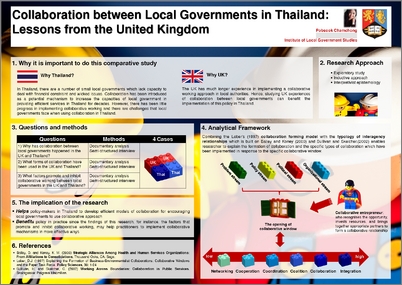 Preview |
|
| Connect and connectivity: revealing a world of interactionsConnectivity is embedded into our modern day society. Devices rely increasingly on permanent network connections, people keep connected through social networks and technological advances allow everyday objects to become part of large networks of interconnected entities. Within these networks connect... [ more ] Connectivity is embedded into our modern day society. Devices rely increasingly on permanent network connections, people keep connected through social networks and technological advances allow everyday objects to become part of large networks of interconnected entities. Within these networks connectivity allows for the design of novel interaction methods by utilising the digital input and output capabilities of connected entities. However, when specifically designing for interaction, entities become entangled and remain oblivious of each other’s features. This poster presents the current progress in opening up the space of connectivity in order to reveal and make use of the available technological capabilities. Identifying communities of objects, people and devices and provide the means to discover, and make use of the technological properties of each element, treating them as an interacting ecosystem of complex adaptive systems and networks in physical spaces. | | ![[img]](/1732/1.hassmallThumbnailVersion/UGSposter2013Hakvoort_A0.pdf) 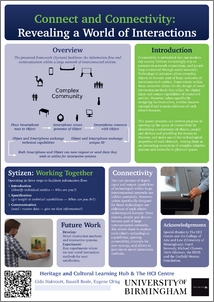 Preview |
|
| Deputy and assistant headteachers: why headship is no longer a choiceIt is an expected view that all deputy and assistant head teachers continue their journey into Headship within schools in England, with the notions of role progression, aspiration and performance development at the heart of the process, but in reality this may not the case. For reasons unknown Heads... [ more ] It is an expected view that all deputy and assistant head teachers continue their journey into Headship within schools in England, with the notions of role progression, aspiration and performance development at the heart of the process, but in reality this may not the case. For reasons unknown Headship is no longer the preferred choice of many deputy and assistant head teachers in England, hence there is now a national headship shortage. It is important to ascertain why this is so, in particular in secondary schools in Birmingham. Therefore, the purpose of this research is to explore and elicit the reasons as to why 20 deputy and assistant head teachers do not want to enter into the headship role in secondary schools in the Birmingham area. Very little literature has been found about the specific role of the assistant head teacher so it is assumed that the assistant headship role is similar to that of the deputy headship role with a variation of some of the overall responsibilities depending on the school structure and with the responsibilities undertaken when the Head teacher is absent. The following questions will be used to gain further insight into this area: 1. What are the views of deputy and assistant head teachers on why they do not want to become head teachers? 2. What are the perceived barriers and hindrances experienced by deputy and assistant head teachers to becoming head teachers? 3. Which management/training strategies can be used to address these perceived “barriers” and “hindrances” to headship? After reviewing other methodological choices and reflecting on the purpose of the research, the multiple case study deemed most appropriate in the suitability of generating data in order to effectively elicit the reasons as to why assistant and deputy head teachers did not want to enter into headship. A purposive sample size of 20 deputy and assistant head teachers was used, applying a predominantly qualitative approach, in order to delve deep into the perceptions and experiences of educational leaders. Semi-structured interviews along with closed-ended questionnaires were the methodological tools used to gather data for the study. Due to this study being based on the individual interpretations of the lived experience in the deputy and assistant head teacher role, an epistemological stance linked to an interpretivists perspective was applied. This perspective supports the understanding and acceptance of “multiple realities” which would lean towards elements of subjectivity when examining life histories. The Deputy and Assistant Head teacher interviews have revealed a contentment and mastery within the role albeit being a role of many responsibilities and challenges; however the headship role is not favoured as a career aspiration. The research presents both overt and covert barriers and hindrances, which have affected the career journey of deputy and assistant head teachers in their ‘expected pursuit’ of headship. Further examination into management strategies to address the internal and external barriers and hindrances to headship are addressed. I conclude that a holistic approach in understanding the career journeys of teachers needs to be considered in the teaching role with the implementation of a clear, ongoing career structure at all stages within the role. Ongoing support through mentoring and coaching could affect the decision-making process of potential deputy, assistant and head teachers in the future when considering headship. With the national headship crisis at the forefront of the education agenda, this research provides regional insight into the personal accounts and experiences of deputy and assistant headship in Birmingham schools along with recommendations for future management strategies with the aim of informing educational policy regarding the development of future leaders. | | ![[img]](/1738/1.hassmallThumbnailVersion/UGSposter2013Buckley.pdf)  Preview |
|
| How stressed do you get?: A negative personality constellation is associated with higher feelings of stress but lower blood pressure, heart rate, and hormone responses to stressful experiences
An individual’s personality is often seen to be composed of varying levels of positive and negative characteristics; these can in turn influence numerous aspects including how we respond to mental stress. Exaggerated cardiovascular reactions, namely heart rate and blood pressure responses, have been... [ more ] An individual’s personality is often seen to be composed of varying levels of positive and negative characteristics; these can in turn influence numerous aspects including how we respond to mental stress. Exaggerated cardiovascular reactions, namely heart rate and blood pressure responses, have been associated with an increased risk of developing hypertension (high blood pressure) and further cardiovascular disease outcomes. Similarly, exaggerated cortisol (a hormone released during stress) reactivity has been associated with anti-social disorders and increased disease susceptibility. Recent research, however, demonstrates low reactivity is associated with a range of adverse outcomes including depression, substance addiction, and disordered eating. Given the detrimental health and behavioural associations, the aim of the present study was to determine whether different personality traits affect how we perceive and biologically respond to a stressful experience. 352 middle aged Dutch men and women were exposed to three tasks designed to create mental stress; Stroop task (color-word conflict challenge), mirror tracing (a star had to be traced that could only be seen in mirror image), and a speech task (defending themselves against a shoplifting allegation). Heart rate, blood pressure, and cortisol were measured at rest and in response to the stressful experiences. Individuals subsequently completed the Big Five Inventory to assess their levels of five key personality traits: 1 negative trait- neuroticism (tendency to experience negative emotions), and 4 positive traits- agreeableness (willingness to be helpful and social towards others), openness to experience (tendency to be creative and imaginative), extraversion (inclination to be energetic and sociable), and conscientiousness (related to high determination and self-discipline). Those scoring higher in neuroticism actually demonstrated lower heart rate, blood pressure, and cortisol stress responses, despite reporting greater perceptions of task stressfulness and difficulty, and lower feelings of control. Conversely, individuals who were more agreeable and open had greater heart rate and cortisol reactions, despite more open individuals reporting greater control and lower levels of stressfulness and difficulty. These results suggest that the level of stress we may actually feel is not always reflected in our physical responses. A possible reason for this is because over time, if we consistently report greater stressfulness levels such as those individuals with high neuroticism, the body may actually adapt to respond less; a process known as allostatic load. Accordingly, this may protect the individual from the harmful consequences of exaggerated physical responses which have been linked to high blood pressure, heart disease, and their related deaths. Conversely, it would appear that those with a negative set of personality traits, i.e. high neuroticism, and low agreeableness and openness, demonstrate lower biological stress responses. These findings further support a growing body of evidence which suggests that blunted stress reactivity may be maladaptive, and possibly reflect emotional and motivational dysregulation in the brain. The results suggest it may be possible to identify individuals characterised by a personality profile which renders individuals vulnerable to adverse health and behavioral outcomes, thus allowing individual support to be provided to prevent such negative consequences. Future research aims to determine additional health and behavioural outcomes which may be characterised by this blunted stress reactivity. | | ![[img]](/1739/1.hassmallThumbnailVersion/UGSposter2013Bibbey.pdf) 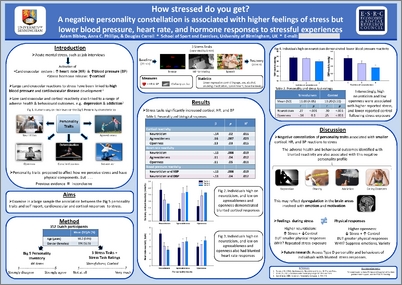 Preview |
|
| Identifying COPD in primary care: targeting patients at the highest riskAim: To select and internally validate candidate variables for a risk prediction algorithm to detect chronic obstructive pulmonary disease (COPD) in primary care. Background: COPD is vastly under-diagnosed in primary care and a variety of case finding and screening tools have been proposed to hel... [ more ] Aim: To select and internally validate candidate variables for a risk prediction algorithm to detect chronic obstructive pulmonary disease (COPD) in primary care. Background: COPD is vastly under-diagnosed in primary care and a variety of case finding and screening tools have been proposed to help identify patients with undiagnosed disease. Risk prediction algorithms have been developed for a variety of diseases but the development and use of such models for identification of COPD in the UK is currently limited. We used routine primary care data to identify and internally validate candidate variables for inclusion in a risk prediction model for COPD in primary care. Method: We performed a literature search to identify potential risk factors associated with COPD. We then extracted data on 17,719 patients with an incident diagnosis of COPD (from 1st January 1990 to 31st March 2006) and 35,944 age-, sex-, and practice-matched controls from the General Practice Research Database and randomised them in a 2:1 ratio to form derivation and validation samples, respectively. The prevalence of a variety of clinical risk factors in the derivation sample (recorded at least 60 days prior to the diagnosis of COPD or equivalent matched time point for controls) was summarised. The unadjusted association between COPD and these risk factors was assessed using fixed effects conditional logistic regression. Candidate predictors were initially scoped from the literature search and then selected for a combined model based on the difference in prevalence between cases and controls, clinical face validity, and the size and statistical significance of their unadjusted odds ratios (ORs≥1.5 with p<0.05). The adjusted ORs were then estimated from a random intercept model. This model was used to formulate a risk prediction algorithm and was tested on the validation sample to assess its accuracy as measured by the area under the receiver operator characteristic curve (AUC or c-statistic) and calibration slope. Analyses were performed using Stata version 10.1. Results: The mean age in the derivation sample was 69.7 years (SD 11.0) and 51.8% were male.Smoking status, salbutamol prescriptions and dyspnoea were the strongest predictors of COPD. Altogether nine variables were included in the combined risk prediction model including symptoms of wheeze and cough, previous diagnosis of asthma and lower respiratory tract infections (LRTI), and prescriptions of prednisolone and antibiotics for a chest infection. When tested on the validation sample this risk prediction algorithm had an AUC of 0.875 (95% CI 0.87 to 0.88). A cutpoint of 0.3 yielded a sensitivity of 86.6% and specificity of 70.1%. The algorithm performed good estimates against risk group deciles with a calibration slope of 0.98 (95% CI 0.87 to 1.10). Conclusions: A risk prediction algorithm that includes smoking status, history of asthma and LRTI, symptoms of dyspnoea, wheeze and cough and prescriptions of salbutamol, antibiotics for respiratory infections and prednisolone appears to be highly predictive of incident COPD in primary care. This model, combined with age and sex, will be further developed and externally validated in a large screening trial for COPD in primary care (Birmingham Lung Improvement Studies, TargetCOPD). An externally validated risk prediction algorithm with sufficient sensitivity and specificity could be used to identify patients in primary care who might benefit from spirometry testing to detect COPD. | | ![[img]](/1734/1.hassmallThumbnailVersion/UGSposter2013Haroon.pdf)  Preview |
|
| Lesbian pulp fiction and community formation 1950-1969The study of lesbian pulp fiction is an integral aspect of working against what Adrienne Rich calls ‘Compulsory Heterosexuality.’ Society has a tendency to assume an individual’s identity in heterosexual terms: assuming that a community is comprised of heteropatriarchal family structures. Using alte... [ more ] The study of lesbian pulp fiction is an integral aspect of working against what Adrienne Rich calls ‘Compulsory Heterosexuality.’ Society has a tendency to assume an individual’s identity in heterosexual terms: assuming that a community is comprised of heteropatriarchal family structures. Using alternative definitions of community, my research investigates the formation of lesbian community around the readership of lesbian pulp fiction and lesbian periodicals published between 1950 and 1970. As a proto-political group, the lesbian communities that formed in the United States were able to access a sense of self and community – in part – because of lesbian publications. Through sociological and historical methods, I investigate both historical communities and the portrayal of lesbian community in genre fiction. In order to do so, I have consulted sociological texts for a working definition of ‘community.’ As these definitions lack cohesion and assume heterosexuality in all members of society, I have consulted the work of lesbian separatist groups in the 1970s. These groups – such as The Furies and Radicalesbians – and feminist sociologists and philosophers produced work that helped to question heteropatriarchal definitions of ‘community.’ While an anachronistic approach, using 1970s feminism and subsequent Queer Theory into a redefinition of community is vital to counteracting compulsory heterosexuality. The objective of my research is to incorporate Queer and Feminist (and ‘queer feminist’) concepts of community and individuality into the analysis of Lesbian Pulp Fiction. While anachronistic to a historical study of 1950s and 1960s lesbian communities, using more contemporary theories would address the role that lesbian pulps once held in lesbian community formation. Moreover contemporary feminist and Queer Theory could figure the analysis of how lesbian pulp fiction is read both inside and outside present-day lesbian communities. Thus far, I have found that the definition of community need not adhere to the confines of geographical space. Through epistolary contact and mass-produced publication --lesbians reading pulp fiction and lesbian-produced magazines (such as The Ladder)--allowed for individuals to be part of a community. For the purposes of my study, community has come to mean: a network of individuals who provide emotional guidance and support for others; a group that helps the individual feel less isolated and alone in the face of adversity. Using this definition, I will be able to conduct further textual analysis on the portrayal of lesbian community and the characterization of lesbian identity in my primary texts. Additionally, I will be able to investigate the function of space (or lack of space) in lesbian pulp fiction and other lesbian narrative disseminated during the 1950s and 1960s. | | ![[img]](/1731/1.hassmallThumbnailVersion/UGSposter2013Stratton.pdf) 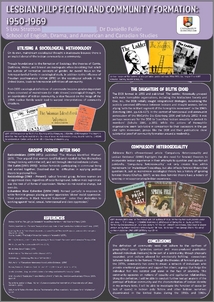 Preview |
|
| Modeling accents for automatic speech recognitionIn British English the term 'accent' refers to systematic variations in pronunciation, often associated with particular geographic regions. Accent is one of the most frequently cited causes of variability in speech. The problem of accents is becoming more important with the advancement of computeris... [ more ] In British English the term 'accent' refers to systematic variations in pronunciation, often associated with particular geographic regions. Accent is one of the most frequently cited causes of variability in speech. The problem of accents is becoming more important with the advancement of computerised services and Automatic Speech Recognition (ASR) systems. Speech recognition technology is used in a wide range of applications and services such as health care, education, automated call centres, authentication and information services. In many of these applications accents and foreign languages posed a problem for speech recognition developers because, if the people using the system could not be understood, they might become frustrated and stop using the system. For example, a recent news story reported that an automated phone system deployed by Birmingham City Council could not cope with ‘Brummie’ accents [1]. This research investigates how we can exploit the knowledge of accents to obtain both rapid and robust ASR systems for British accented utterances using only 30 seconds of speech. When we hear another person’s speech for the first time, we quickly establish a 'profile' of that person based on his or her speech, in terms of factors such as gender, age, accent, and social group. It is possible that we use this characterization to adapt very quickly to that person’s speech. Current ASR systems typically differentiate between genders, but otherwise tend to ignore important factors including accents. Additionally, conventional adaptation techniques for ASR require a substantial amount of training material from each individual to be able to adapt the system in order to have a more user specific system. Now the question is whether the concept of ‘regional accent’ is useful to overcome these two problems. The first section describes the techniques used to visualise the space where accent recognition is performed, otherwise known as the ‘accent recognition’ space, and show the extent to which the emergent structure is consistent with subjective notions of accent. The two techniques used are Principal Component Analysis (PCA) and Linear Discriminant Analysis (LDA). We then interpret speech recognition results on accented speech from 14 different British regions, analysed in terms of their structure in the ‘accent recognition’ space. Following this we present results on accent adaptation using conventional adaptation techniques such as MAP (Maximum A Posteriori Adaptation) and MLLR (Maximum Likelihood Linear Regression). We use these accent adaptation techniques along with the knowledge from accent recognition techniques, such as the ACCDIST accent recognition measure, to provide an accent robust, rapid speaker adaptation system. 1. “Brummie accents baffle automated phone system ... at Birmingham City Council”, Daily Mail, 5th November 2012. | | ![[img]](/1736/1.hassmallThumbnailVersion/UGSposter2013Najafian.pdf)  Preview |
|
| Optimal cycling time trial position modelsIntroduction: The aerodynamic drag of a cyclist in time trial (TT) position is strongly influenced by the torso angle (Underwood et al. 2011). To minimize drag, cyclists lower their torso angle. Along with the drag the cyclists’ peak power output decreases. There should be a trade-off between the lo... [ more ] Introduction: The aerodynamic drag of a cyclist in time trial (TT) position is strongly influenced by the torso angle (Underwood et al. 2011). To minimize drag, cyclists lower their torso angle. Along with the drag the cyclists’ peak power output decreases. There should be a trade-off between the loss in power output and drag as function of cycling velocity. This hypothesis is supported by the energy expenditure which is a function of the workload divided by the gross efficiency (GE). The workload to overcome drag decreases with smaller torso angles, while the GE decreases accordingly. Previous literature suggested that the aerodynamic losses outweigh the loss in power output (Lukes et al. 2005). However, these statements are only valid for elite TT cycling velocities, e.g. > 45 km/h. To our best knowledge, there is no published prediction at which speed the aerodynamic power loss starts to dominate. Therefore the aim of this study is to predict the optimal TT cycling position as a function of velocity to improve the performance of non-elite cyclists. Methods: Two models were developed to determine the optimal torso angle of TT cyclists: a ‘Power Output Model’ and a ‘Metabolic Efficiency Model’. The Power Output Model predicts the optimal cycling position by maximizing the peak power output minus the power losses due to drag and roll resistance. The Metabolic Efficiency Model minimizes the required cycling energy. Model input parameters were experimentally collected of 19 trained competitive time trial cyclists (Fintelman et al. 2012). The main input variables were the power output, frontal area and GE of the cyclists in different torso angle positions (0,8,16 and 24°). The optimal cycling torso angle was predicted for speeds between 18-50km/h. Results and discussion: For both models, the optimal torso angle is dependent on the cycling velocity, and the torso angle exhibited a sigmoid-like shape, with decreasing torso angles at increasing velocities. The Power Output Model curve was shifted to a higher velocity, which could be explained by the different approach of the models. The aerodynamic losses outweighed the power losses for velocities above 45km/h, which goes in line with the literature. For cycling velocities below 30km/h the power loss and gross efficiency due to position change were dominant. Furthermore, it is shown that a fully horizontal torso is not optimal. Conclusion and recommendations: It is suggested that despite some limitations, the models give valuable information about the optimal TT cycling position at different speeds for non-elite cyclists. This study showed it is beneficial to ride in a more upright TT position when velocities are below 30km/h, while at speeds above 45km/h an almost flat back is optimal. Furthermore, for speeds between 32-40km/h in an endurance event it is advisable to lower the torso despite the fact that the power output in a more aerodynamic position is decreased. In contrast, in sprinting or in variable conditions (wind, undulating course, etc) at these speeds it is more beneficial to ride in a more upright TT position. Our future research will attempt to measure the aerodynamic drag of all participants in a wind tunnel, to implement a more valid drag coefficient and thus improving the validity of the models. Furthermore, to increase the ecological validity the effect of crosswind will be implemented in future. References: Fintelman, Highton, Adams, Sterling, Hemida, Li (2012) ECSS annual conference. Lukes R, Chin S, Haake S (2005). Sports Eng., 8(2): 59-74. Underwood L, Schumacher J, Burette-Pommay J, Jermy M (2011). Sports Eng., 14(2): 147-154. | | ![[img]](/1740/1.hassmallThumbnailVersion/UGSposter2013Fintelman.pdf) 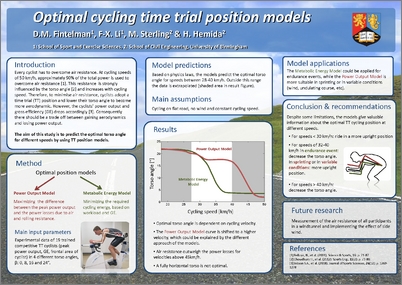 Preview |
|
| Predicting bowel cancer in chronic Ulcerative ColitisBackground: Ulcerative Colitis (UC) is an aggressive and incurable inflammatory bowel disease that affects young people typically in their teens and early twenties. The symptoms of UC include, bloody diarrhoea, incontinence and intractable fatigue that can be difficult to treat. There are almost 250... [ more ] Background: Ulcerative Colitis (UC) is an aggressive and incurable inflammatory bowel disease that affects young people typically in their teens and early twenties. The symptoms of UC include, bloody diarrhoea, incontinence and intractable fatigue that can be difficult to treat. There are almost 250, 000 patients with UC in the UK alone. Patients with UC for more than 8 years have a ten times increased risk of bowel cancer and undergo regular endoscopic surveillance of their large bowel. Unfortunately almost 50% of cancers are missed even in patients on surveillance. Furthermore cancer can develop in between surveillance episodes. There is a clear need to develop improved ways of predicting cancer in such patients. Pilot data: DNA methylation is a key early event in many cancer types including bowel cancer. DNA methylation of genes involved in the Wnt pathway have been investigated previously by our group and shown to be silenced as a result of methylation. These events occur early in UC bowel cancers. Methylation of Wnt genes occurs not only in the cancer but also in surrounding bowel tissue suggesting that such changes may be ‘gatekeeper’ events for neoplastic transformation to occur. Methods: This study aims to investigate the timeline of Wnt gene methylation and determine if these can be used within a clinical setting to PREDICT cancer in UC patients. To do this, 55 archived cancers from patients with UC will be analysed including colonic biopsies of the same patients taken up to three years before the development of cancer. DNA methylation changes will be analysed in all samples and will be compared to biopsies of UC patients that have similar disease parameters but no cancer. This study will help determine if such biomarkers can predict the onset of cancer in UC patients and if so determine the clinical lead-time that can be achieved through using this analysis as an adjunct to current surveillance strategies. Outcomes: The outcome of such a study could lead to the development of a DNA based test that could enhance cancer risk stratification of UC patients. This could prevent hundreds of cancers each year in this young population. | | ![[img]](/1733/1.hassmallThumbnailVersion/UGSposter2013Iqbal.pdf) 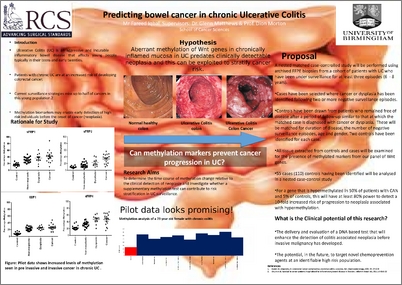 Preview |
|
| Will the sedentary smartphone owner please stand up?: Breaking bad health habits using technologyThere is mounting evidence that sedentary lifestyles can seriously impact on health, contributing to obesity, cardiovascular problems and early mortality. At the same time, the increasing ownership of smartphones equipped with sensors that can accurately detect sedentary patterns presents an opportu... [ more ] There is mounting evidence that sedentary lifestyles can seriously impact on health, contributing to obesity, cardiovascular problems and early mortality. At the same time, the increasing ownership of smartphones equipped with sensors that can accurately detect sedentary patterns presents an opportunity for pervasive technological interventions that target sedentary behaviour. Several approaches have been developed within the Human-Computer Interaction (HCI) field of persuasive technology. However, such approaches tend to overlook existing research from psychology that demonstrates that strongly habitual behaviour is relatively impervious to interventions that simply provide information and feedback. This poster explores the application of habit formation and dual process theories to the practical development of effective pervasive persuasive sedentary behaviour change interventions. It explores theoretical underpinnings of why people develop sedentary habits, how technology could help to break these habits and form healthier ones, the expected difficulties that need to be overcome, and the proposed methodological approaches to evaluating such interventions. | | ![[img]](/1735/1.hassmallThumbnailVersion/UGSposter2013Pinder.pdf) 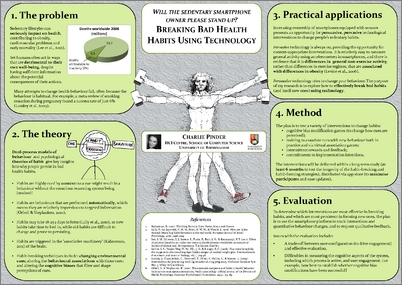 Preview |
|
|
This list was generated on Fri Apr 4 01:46:24 2025 IST. |

